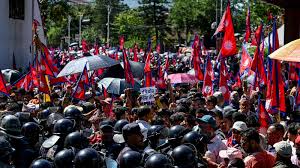Nepal observes 18th Republic Day as monarchists hold rally

On May 28, 2025, Nepal marked its 18th Republic Day. This day celebrates the abolition of the centuries-old monarchy. It also marks the establishment of the Federal Democratic Republic in 2008. While the country celebrated, large-scale pro-monarchy demonstrations revealed a deep divide in Nepalese society.
Commemorating the Republic’s Journey
Republic Day marks the end of the Shah monarchy. This dynasty ruled Nepal for more than two centuries. The monarchy ended after years of political upheaval. These included a decade-long Maoist insurgency and protests against King Gyanendra’s autocratic rule. Nepal became a republic in 2008, promising democracy, secularism, and inclusivity for its diverse population.
On the 18th anniversary, government leaders and citizens gathered nationwide. They honored Nepal’s democratic progress. Events highlighted improvements in education, infrastructure, and minority rights. President Ram Chandra Poudel spoke to the nation. He acknowledged ongoing challenges like political instability and economic struggles. Still, he said the republic reflects the people’s will.
Prime Minister Khadga Prasad Oli gave a similar message. He called for unity and stressed democratic values. “The republic is more than a system. It symbolizes the sovereignty of our people,” he said. Oli urged all Nepalese to work together to face difficulties.
The Monarchist Rally: A Powerful Counter-Narrative
Despite official celebrations, many royalists gathered in Kathmandu. Thousands of supporters of the Rastriya Prajatantra Party (RPP) rallied for the return of the constitutional monarchy. They also demanded Nepal’s Hindu state status be restored. This status was removed from the constitution in 2015.
The demonstrators held portraits of former King Gyanendra Shah. They chanted slogans such as “Bring the king back to the throne” and “Restore our nation’s pride.” This rally was one of the largest pro-monarchy gatherings in recent years. It showed renewed energy in royalist causes.
Monarchists point to the republic’s failures as their motivation. Many citizens are frustrated with political instability. Frequent government changes and corruption allegations fuel this frustration. Economic development has also lagged. Some Nepalese look back fondly on the monarchy for providing stability and unity.
Managing Tensions and Security Concerns
The government worked hard to manage the celebrations and the rally. They deployed around 6,000 security personnel, including riot police. Separate locations and times were arranged for the republic and monarchist events. This move aimed to avoid clashes.
Tensions ran high throughout the day. Police reported some minor scuffles with protestors. Thankfully, no major violence occurred. Still, the size and passion of the crowds highlighted deep divisions in Nepal.
Political Implications and Future Prospects
The monarchist movement has vocal support, especially in cities and among youth. However, it lacks strong political power. The RPP holds only 13 of 275 seats in parliament. This number is far from the two-thirds majority needed to amend the constitution.
Restoring the monarchy would require major legal changes. The country’s political framework remains firmly republican. Many mainstream parties oppose monarchy restoration. They see the republic as a vital achievement for democracy and inclusion.
Still, the large monarchist rallies reveal unresolved grievances. They reflect nostalgia for Nepal’s identity as a Hindu kingdom. This identity was officially set aside in the 2015 constitution that declared Nepal secular.
Historical Context: From Monarchy to Republic
The Shah dynasty ruled Nepal for over 200 years. The monarchy was a key source of national unity and identity. However, the Maoist insurgency from 1996 to 2006 exposed many inequalities. It also highlighted political repression under the monarchy.
The insurgency ended with a peace agreement calling for reforms. King Gyanendra’s direct rule from 2005 to 2006 sparked widespread protests. Citizens demanded democratic governance.
In 2008, Nepal’s Constituent Assembly voted to abolish the monarchy. The country became a federal democratic republic. Since then, Nepal has worked on building new institutions. The process has faced challenges such as constitutional disputes and ethnic tensions.
Societal Divisions and Identity Politics
The monarchist rally shows Nepal’s deep social divisions. For many, the monarchy symbolizes tradition and cultural continuity. Royalists believe the monarchy provided a unifying figure above politics.
Republicans see the monarchy as outdated and exclusionary. They favor a system that embraces Nepal’s ethnic and religious diversity. The debate also involves Nepal’s religious identity. The 2015 constitution declared Nepal secular, moving away from its Hindu kingdom past.
This clash between tradition and modernity drives much of Nepal’s political discourse. While the republic has expanded civil rights, many doubt it has brought stability or prosperity.
Conclusion
Nepal’s 18th Republic Day showed the country’s ongoing political tensions. The republic symbolizes a historic transformation and hope for democracy. Yet the monarchist rallies reveal unresolved issues and nostalgia.
Leaders face the challenge of addressing public frustration. They must improve governance and the economy. At the same time, they need to uphold democratic principles.
Bridging the divide between monarchists and republicans will require dialogue and reform. Strong institutions will be key to bringing stability.
Nepal’s journey since 2008 is still unfolding. The past and future remain deeply intertwined in the hearts of its people.






